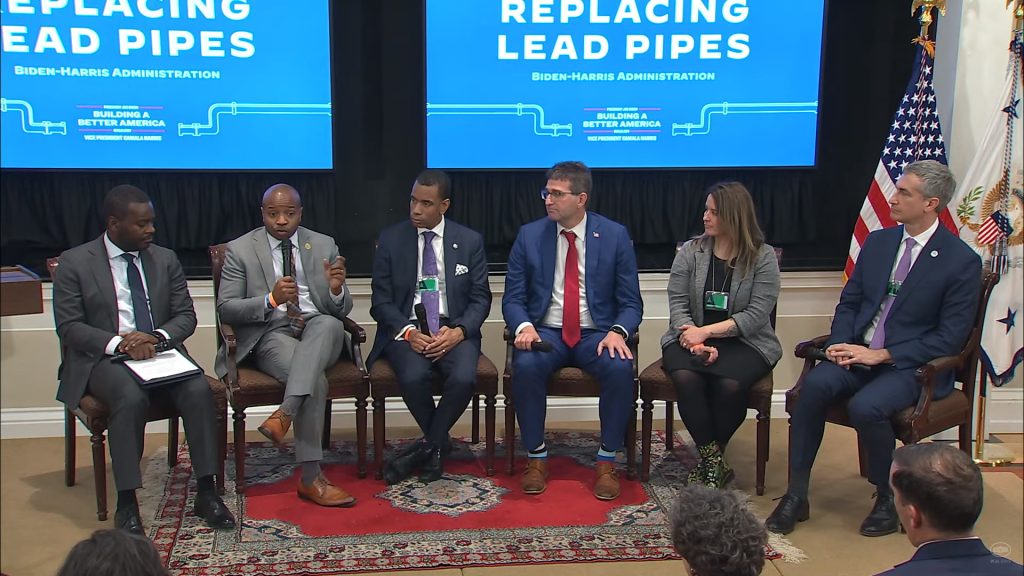Mayor Speaks At White House Lead Summit, City Joins New Partnership
Wisconsin is part of new program aiming to increase pace of lead pipe replacement.

Mayor Cavalier Johnson speaks on panel at White House Summit on Accelerating Lead Pipe Replacement. Image from White House livestream.
Help is on the way to accelerate Milwaukee’s approximately 70-year pace to replace all of its lead service lines. It’s news that Mayor Cavalier Johnson thinks could improve not only public health, but also provide high-quality jobs and reduce violence.
The Environmental Protection Agency is launching a lead service line replacement accelerator program in partnership with Wisconsin, New Jersey, Pennsylvania and the U.S. Department of Labor. The technical assistance program is designed to address everything from identifying lead pipes needing replacement to applying for grant funding to perform the work.
Due to a confluence of factors, including funding availability and contractor capacity, the City of Milwaukee has struggled to meet its goal of replacing approximately 1,000 laterals per year. It has approximately 66,600 laterals remaining. Recent efforts have focused on training a larger pool of workers.
“We’re sort of a microcosm of the larger issue we have around the country,” said Johnson, speaking Friday on a panel at the White House Summit on Accelerating Lead Pipe Replacement. Many of the up to 10 million remaining lead service lines in the U.S. are concentrated in the oldest cities, particularly in the Midwest.
The City of Milwaukee and the Milwaukee Water Works are now two of the 123 cities, states, water utilities and other organizations in the newly-formed White House Get The Lead Out Partnership.
“In Milwaukee, we have worked to draw down resources from the federal government,” said Johnson, thanking Senator Tammy Baldwin and Congresswoman Gwen Moore. “We are building up that new workforce.”
Vice President Kamala Harris and infrastructure czar Mitch Landrieu both made visits to Milwaukee in 2022 to tout aspects of the $1.2 trillion infrastructure law. Both highlighted the city’s partnerships to grow its workforce. Harris toured WRTP/BIG STEP‘s training facility.
Wisconsin is to receive approximately $50 million annually to expand its lead lateral replacement programs.
“It’s going to create an opportunity for us to expand on our work,” said the mayor. “And we’re going to be able to do it in an equity-focused way.” That includes identifying elevated blood-lead-level hot spots, considering socio-economic factors and the density of lead service lines in an area.
He said the city’s efforts over the past six years are a national example. The City of Milwaukee has established a cost-sharing, mandatory-replacement program in the event of a break and freely replaces laterals at child care facilities. It also includes information on lead in water in its municipal services (formerly water) bills.
“We need the additional resources,” said Johnson. He said he was pleased the president and vice president have established an urgency on the issue.
“If you want things to get done, if you want projects to happen, if you want lead services lines to get pulled out of the ground, then send resources directly to cities. Send those resources directly to mayors. We’re where the rubber meets the road. We get things done,” said the mayor.
Johnson said lead service replacement could be Milwaukee’s “Maynard Jackson type of moment.” His comment was in reference to the former Atlanta mayor’s leadership of the construction of the city’s airport and the resulting creation of a large Black middle class through minority contracting.
Also speaking on Johnson’s panel were Wausau Mayor Katie Rosenberg, Rochester, NY Mayor Malik Evans, Ann Arbor, MI Mayor Christopher Taylor and New Castle, Delaware County Executive Matthew Meyer.
Other participants in the event included Wisconsin Department of Natural Resources Secretary-designee Adam Payne and Milwaukee resident Deanna Branch.
The event concluded with an address from the vice president.
Friday’s event did not include any lengthy discussion of lead paint remediation. A separate federal program funds that effort. Milwaukee’s focus on lead poisoning abatement was driven in part by the revelation in 2018 of failings and poor practices by the Milwaukee Health Department‘s Childhood Lead Poisoning Prevention Program. A 2021 Common Council allocation of American Rescue Plan Act funds included millions for the health department to expand its lead programs.
The Milwaukee Water Works is budgeting to replace 1,200 service lines next year.
The city-owned utility, which sells water to 16 municipalities, is limited on where it can derive funding from to replace laterals due to state utility regulations. It cannot use funds from customers to replace laterals at its own discretion. Further complicating the matter, because the service line is partially privately owned, the city cannot force replacement in many cases
Any house built before 1978, which accounts for most of the houses in Milwaukee, is likely to include lead paint. The last lead service line in the city was believed to be installed in 1962. City officials have repeatedly insisted that lead paint is the biggest danger, but that no amount of lead is safe if ingested. Interior plumbing, beyond the service line, is also likely to include lead. Individuals concerned about lead poisoning can learn more about lead-safe filters and testing on the MWW website. MWW also maintains a database of properties with known lead service lines.
Johnson was also in Washington D.C. last week to attend the United States Conference of Mayors winter meeting.
If you think stories like this are important, become a member of Urban Milwaukee and help support real, independent journalism. Plus you get some cool added benefits.




















